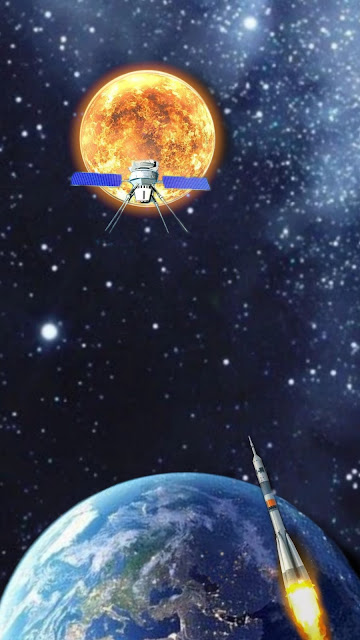Aditya L1 Mission | Aditya L1 mission launch date | Aditya L1 mission 2023 |National Solar Mission by India
The first space-based mission from India to investigate the Sun is called Aditya L1. On September 2, 2023, ISRO launched it from Sriharikota using a PSLV-C57 rocket. The mission's objectives include studying the mechanisms that generate solar wind and heat the solar corona, the Sun's outer layers.
Seven scientific payloads, including four for remote sensing and three for in-situ experiments, are carried by the 1,472 kilogram spacecraft. The solar low energy X-ray spectrometer (SoLEXS), the solar ultraviolet imaging telescope (SUIT), the visible emission line coronagraph (VELC), and the high energy L1 orbiting X-ray spectrometer (HEL1OS) are among the remote sensing payloads. A plasma analyzer package for Aditya (PAPA), an Aditya solar wind particle experiment (ASPEX), and an Aditya solar wind experiment, sophisticated tri-axial digital magnetometer with excellent resolution.
The spacecraft is positioned in a halo orbit 1.5 million kilometers from Earth, at the Lagrange point 1 (L1) of the Sun-Earth system. The spacecraft may orbit the Sun and the Earth with the least amount of fuel by doing so at L1, where their gravitational pulls are balanced. Additionally, its orbit offers a constant view of the Sun free from occultation by the Earth or Moon.
The mission is anticipated to offer insightful knowledge regarding the dynamics and evolution of the Sun and its impact on the climate and space weather of the Earth. Additionally, it will support global initiatives to comprehend and forecast solar flares, coronal mass ejections, and other solar phenomena that can have an impact on people's actions on Earth and in space.
Know all about CHANDRAYAN 3 MISSION
How does Aditya L1 differ from other solar missions?
In a number of ways, Aditya L1 is unique from prior solar missions. Some of the biggest variations include:
- Aditya L1 is India's first mission to study the Sun from space. There have been other solar missions launched by nations including the United States, Japan, and Europe.
- Aditya L1 is the first mission to launch a satellite into a halo orbit around the Sun-Earth system's L1 point. Different orbits, such as elliptical, polar, or heliocentric orbits, have been employed by other missions.
The visual emission line coronagraph (VELC), which will produce high-resolution photos of the solar corona and its dynamics, is being carried for the first time on Aditya L1 mission. Other missions have observed the Sun using a variety of sensors, including X-ray telescopes, ultraviolet imagers, and spectrometers.
- Aditya L1 is anticipated to be a financially sensible mission. The Government of India had set aside a budget of around Rs. 378.53 crore for the solar mission, excluding launch costs2, according to information from a previous Lok Sabha inquiry, even though ISRO has not yet provided the most recent cost breakdown of the mission. Other projects, like NASA's Parker Solar Probe, which cost roughly $1.5 billion, had significantly greater expenditures.
How long will Aditya L1 mission last?
- Initially planned to span **five years**, the Aditya L1 mission may be prolonged based on how well the spacecraft and its sensors function. After launch, the mission will take around 109 Earth days to get to the L1 point's halo orbit, which is about 1.5 million kilometers away. For the life of its intended mission, the spacecraft will stay in the halo orbit while being maintained at a station keeping cost of 0.2 to 4 m/s per year. Scientists will be able to comprehend solar processes and their effects on Earth and space with the aid of the mission's continuous and uninterrupted studies of the Sun and its corona.
 |
| Aditya l1 mission / Chandrayaan 3 |
Why is it important to study the Sun?
There are numerous benefits to studying the Sun. Some of them are as follows:
- The Sun provides the Earth and other planets in the solar system with both life and energy. It has an impact on Earth's climate, weather, and seasons. Additionally, it affects the biological cycles and behaviors of living things.
- The Sun is the only star we can closely view because it is the closest one to our planet. We can learn more about how other stars in the universe arise, evolve, and behave by studying the Sun.
- Sunspots, solar flares, coronal mass ejections, and solar wind are just a few examples of the Sun's many different phenomena. The Sun is a dynamic and energetic star. The space environment around the Earth and other planets may be impacted by these occurrences.
- These events have the potential to disrupt power, communication, and navigational systems in the space environment surrounding the Earth and other planets. They may also provide risks to spacecraft and astronauts.
- We can foresee and lessen the consequences of solar activity on Earth and space by studying the Sun. It can also assist us in investigating the feasibility of using solar energy for our purposes.
What are challenges to study sun ?
The study of the Sun is both interesting and difficult. Several of the difficulties are:
- It is challenging to send spacecraft and probes to the Sun to conduct up-close observations since it is so far away from Earth—about 149 million km on average. The atmosphere of the Sun reaches millions of degrees in temperature. This means that any spacecraft approaching the Sun must be able to resist extremely high temperatures and radiation while also avoiding being incinerated by the solar wind. Sunspots, solar flares, coronal mass ejections, and solar wind are just a few of the many phenomena the Sun produces because it is so dynamic and energetic. These events may have an impact on the space environment surrounding the Earth and other planets, disrupting power, navigation, and communication systems.
- They could also be dangerous for spacecraft and astronauts. Many facets of the Sun's structure and behavior are currently unclear or poorly understood, making it an extremely complicated and enigmatic object. For instance, researchers are still working to fully comprehend how the Sun creates its magnetic field, how it heats its corona, and how it controls the solar cycle.
At the end this mission is helpful for human life
- The mission is anticipated to offer insightful information regarding the dynamics and evolution of the Sun and its impact on the climate and space weather of the Earth. Additionally, it will support international efforts to comprehend and foresee solar flares, coronal mass ejections, and other solar phenomena that may have an impact on human activities on Earth and in space.


